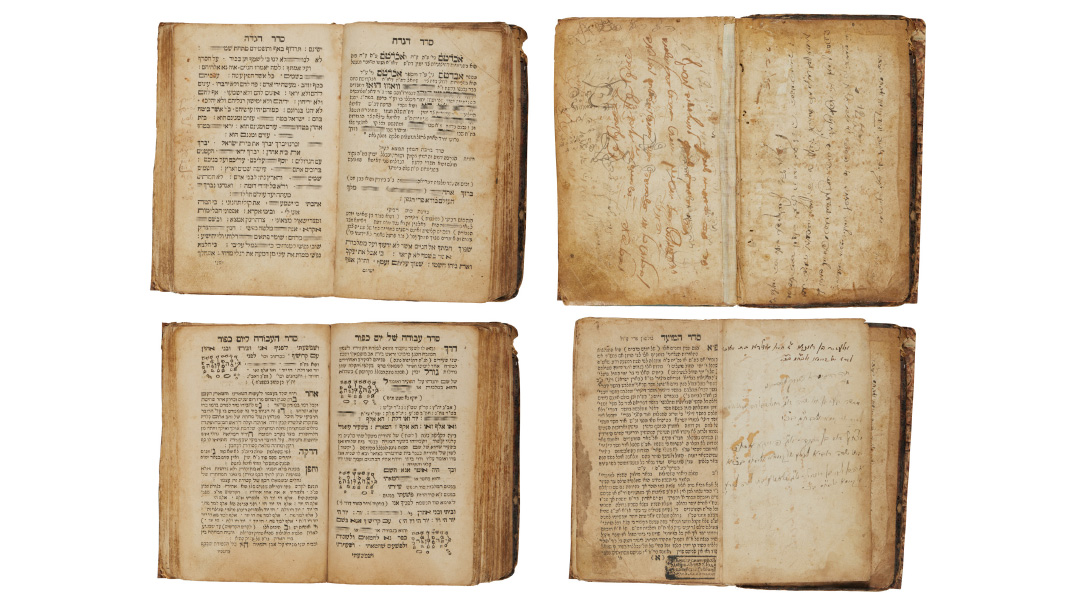Davening with the Berditchever
| June 14, 2022Rav Levi Yitzchak of Berditchev (1740–1809) is one of the most beloved figures in the annals of the chassidic movement

The treasured siddur of Rav Levi Yitzchak of Berditchev is part of the Sotheby’s “Important Judaica” auction scheduled for Thursday, June 16
Title: Davening with the Berditchever
Location: Berditchev, Ukraine
Document: Siddur of Rav Levi Yitzchak of Berditchev
Time: circa 1800
Though he never established a formal court, Rav Levi Yitzchak of Berditchev (1740–1809) is one of the most beloved figures in the annals of the chassidic movement. Born into a prominent rabbinic family in Poland, he was introduced to chassidus by Rav Shmuel Shmelke Horowitz, who in turn sent him to Rav Dov Ber, the Maggid of Mezritch, and Rav Levi Yitzchak emerged as one of his greatest disciples.
He succeeded the Rebbe Rav Shmelke in the rabbinate of Ryczywol when the latter migrated to Nikolsburg in Moravia, and subsequently served as the rabbi of Zelechow, Pinsk, and Berditchev. An able rabbi, posek, teacher, and disseminator of chassidic teachings — he published his Kedushas Levi in 1798 and 1806 — two of his unique qualities gained him renown. With the appellation “Defender of the Jewish People” attached to his name for posterity, he famously went to great lengths to seek out the good in every Jew, and stories abound of his creative efforts in this regard. Another characteristic was the way he prayed, which left an indelible impression on those who witnessed it.
Praying for banei, chayei, mezonei for his people combined his animated approach to davening with his boundless ahavas Yisrael. In line with his reputation, his descendants assumed the surname Derbaremdiker (Yiddish for compassionate), and they zealously guarded the family heirlooms of their illustrious forebear.
Rav Levi Yitzchak was succeeded in the Berditchev rabbinate by his son Rav Yisrael of Pikow, and it was his descendant Rabbi Chaim Pinchas Derbaremdiker who inherited a prized possession — the siddur from which Rav Levi Yitzchak davened for the salvation of the Jewish People. It contained kavanos of the Arizal, along with inscriptions from petitioners requesting he pray on their behalf.
After surviving the Holocaust in Transnistria, Rav Chaim Pinchas immigrated to Israel, where he hebraicized his name to Rachamani. After enjoying a fruitful career in the Ministry of Religious Affairs and as a congregational rabbi in Tel Aviv, he moved into a retirement home in Bnei Brak. The priceless siddur came with him.
When Rav Rachamani passed away without progeny in 1996, his room was ransacked, and the siddur was gone. It seems even the thieves of Bnei Brak appreciated the value of a siddur used by the Kedushas Levi. A prominent Bnei Brak rabbi named Rav Yoel Tobias was able to have it returned to the heirs stipulated in the deceased’s will. Rav Tobias then authored a certificate of authenticity, stating that “according to [Rav Rachamani], this siddur belonged to his ancestor, saneigoran shel Yisrael, the holy Rav Levi Yitzchak of Berditchev…”
Beyond Berditchev
Not some small shtetl, Berditchev was a large Jewish city in the Pale of Settlement. By the end of the 19th century, the city had more than 40,000 Jews, amounting to some 80% of the population. Social changes sweeping Russia hit Berditchev too, and it went on to produce such notable Jewish residents as the founder of the Yiddish theater, Avraham Goldfaden; the writer Mendele Mocher Seforim; and famous World War II Red Army journalist Vasily Grossman. The Nazi occupation wiped out the large Jewish community in mass graves outside the town. Hashem yinkom damam.
Valuable Assets
While people may be willing to pay a significant sum for the privilege of owning Rav Levi Yitzchak’s siddur, the highest price fetched at auction for a Hebrew single-volume work was an incredible $8.3 million for a Yamim Noraim machzor from the 13th century. Known as the Luzzatto Machzor, it was written in southern Germany in an elegant script accompanied by elaborate illustrations. It was named for one of its owners, Shmuel David Luzzatto, an Italian Jewish scholar from Padua. Speaking of northern Italy, a complete set of the famous Bomberg Shas printed in Venice, went for a whopping $9.3 million in 2015.
(Originally featured in Mishpacha, Issue 915)
Oops! We could not locate your form.






